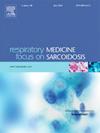确定出现慢性高碳酸血症的严重慢性阻塞性肺病患者的表型。
IF 3.5
3区 医学
Q2 CARDIAC & CARDIOVASCULAR SYSTEMS
引用次数: 0
摘要
前言慢性高碳酸血症是指血液中二氧化碳浓度升高,是严重慢性阻塞性肺疾病的一种严重并发症。它对生活质量产生负面影响,增加住院率,并增加死亡风险。然而,并非所有重度慢性阻塞性肺病患者都会出现慢性高碳酸血症,其潜在机制仍不清楚。确定高碳酸血症的临床和病理生理学预测因素对于制定有针对性的治疗策略至关重要。本研究调查了高碳酸血症与患者特征、肺功能和 CT 扫描特征之间的关系,以确定潜在的治疗目标:这项横断面研究纳入了来自三个队列的1526名慢性阻塞性肺疾病患者:一个标准治疗队列和两个研究队列(NCT04023409;NCT03053973)。收集的数据包括人口统计学和临床信息、血气、肺功能(FEV1、FVC、TLC、RV、DLCOc)和高分辨率 CT 扫描(肺容积、气潴留、肺气肿评分、气道壁厚度(Pi10)和膈肌指数):结果:高碳酸血症的发生率随慢性阻塞性肺疾病的严重程度而增加。高碳酸血症患者年龄更大、更有可能吸烟、合并症更多。他们的 FEV1 和 FVC 值较低,RV/TLC 比值较高,CT 扫描显示肺气肿评分较低,Pi10 较高。多变量分析表明,较低的 PaO2、预测 FEV1% 和肺气肿评分,以及较高的 RV/TLC 比率和 NT-proBNP 水平是 PaCO2 的独立预测因素,共同解释了 46.3% 的变异:结论:慢性阻塞性肺疾病患者长期高碳酸血症的特点是吸烟率较高、PaO2 水平较低、肺功能较差、肺气肿较少以及气道病变增加。这些发现强调了慢性阻塞性肺病患者高碳酸血症的多因素性质,突出了针对这些因素采取个性化治疗策略以改善预后的必要性。本文章由计算机程序翻译,如有差异,请以英文原文为准。
Defining a phenotype of severe COPD patients who develop chronic hypercapnia
Introduction
Chronic hypercapnia, defined by elevated blood CO2 levels, is a serious complication most prevalent in severe COPD. It negatively impacts quality of life, increases hospitalization rates, and elevates mortality risks. However, not all severe COPD patients develop chronic hypercapnia, and its underlying mechanisms remain unclear. Identifying clinical and pathophysiological predictors of hypercapnia is essential for tailored treatment strategies. This study investigates the relationship between hypercapnia and patient characteristics, lung function, and CT scan features to identify potential therapeutic targets.
Methods
This cross-sectional study included 1526 COPD patients from three cohorts: a standard care cohort and two research cohorts (NCT04023409; NCT03053973). Data collected included demographic and clinical information, blood gases, lung function (FEV1, FVC, TLC, RV, DLCOc), and high-resolution CT scans (lung volumes, air trapping, emphysema scores, airway wall thickness (Pi10), and diaphragm indices).
Results
Hypercapnia prevalence increased with COPD severity. Hypercapnic patients were older, more likely to smoke, and had more comorbidities. They exhibited lower FEV1 and FVC, and higher RV/TLC ratios, with CT scans showing lower emphysema scores and greater Pi10. Multivariate analysis identified lower PaO2, FEV1% predicted, and emphysema scores, along with higher RV/TLC ratios and NT-proBNP levels, as independent predictors of PaCO2, collectively explaining 46.3 % of the variance.
Conclusion
COPD patients with chronic hypercapnia are characterized by higher smoking rates, lower PaO2 levels, poorer lung function, less emphysema, and increased airway pathology. These findings underscore the multifactorial nature of hypercapnia in COPD, highlighting the need for personalized therapeutic strategies targeting these factors to improve outcomes.
求助全文
通过发布文献求助,成功后即可免费获取论文全文。
去求助
来源期刊

Respiratory medicine
医学-呼吸系统
CiteScore
7.50
自引率
0.00%
发文量
199
审稿时长
38 days
期刊介绍:
Respiratory Medicine is an internationally-renowned journal devoted to the rapid publication of clinically-relevant respiratory medicine research. It combines cutting-edge original research with state-of-the-art reviews dealing with all aspects of respiratory diseases and therapeutic interventions. Topics include adult and paediatric medicine, epidemiology, immunology and cell biology, physiology, occupational disorders, and the role of allergens and pollutants.
Respiratory Medicine is increasingly the journal of choice for publication of phased trial work, commenting on effectiveness, dosage and methods of action.
 求助内容:
求助内容: 应助结果提醒方式:
应助结果提醒方式:


